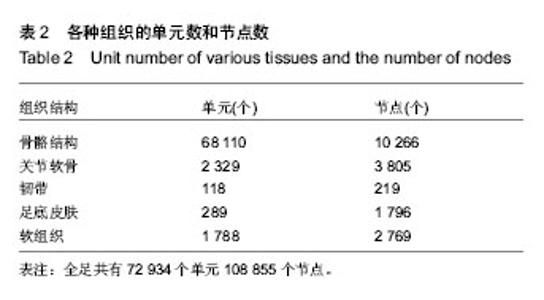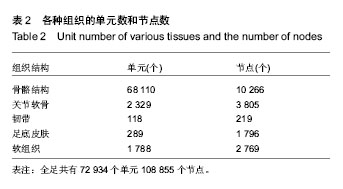| [1] 胡小春,郭松青,叶铭.基于CT图像建立人体足部骨骼三维有限元模型研究[J].合肥工业大学学报:自然科学版,2005,28(9): 1188-1191.
[2] 马如宇,铁瑛,薛文东,等.基于螺旋CT构建人体骨盆三维有限元模型[J].医学生物力学,2004,19(3):180-183.
[3] Gefen A, Megido R, Itzchak Y, et al. Biomechanical analysis of the three-dimensional foot structure during gait: a basic tool for clinical applications. J Biomech Eng. 2000;122:630-639.
[4] Lakin RC, DeGnore LT, Pienkowski D. Contact mechanics of normal tarsometatarsal joints. J Bone joint surg Am. 2001; 83-A:520-528.
[5] Jacob S, Patil MK. Three-dimensional foot modeling and analysis of stresses in normal and early stage Hansen's disease with muscle paralysis. J Rehabil Res Dev. 1999;36: 252-263.
[6] Saunders MM, Schwentker EP, Kay DB, et al. Finite element analysis as a tool for parametric prosthetic foot design and evaluation. Technique development in the solid ankle cushioned heel (SACH) foot. ComPute Methods Biomech Biomed Engin. 2003;6:75-87.
[7] Cheung JT, Zhang M, An KN. Effects of plantar fascia stiffness on the biomechanical responses of the ankie-foot complex. Clin Biomech (Bristol, Avon). 2004;19:839-846.
[8] Patil KM, Jacob S. Mechanics of tarsal disintegration and plantar ulcers in leprosy by stress analysis in three dimensional foot models. Indian J Lepr. 2000;72(1):69-86.
[9] Salathe EP Jr, Arangio GA, Salathe EP. Abiomeehanieal model of the foot. J Biomeeh. 1986;19:989-1001.
[10] Daniel LA, William RL, Eric SR, et al. Athree-dimensional, anatomieally detailed foot model: a foundation for a finite element simulation and means of quantifying foot-bone position. J Rehabil Res Dev. 2002;39(3):401-410.
[11] 张美超,夏虹,樊继宏.人体骨骼有限元几何模型的重建[J].中国临床解剖学杂志,2003,21(5):531-532.
[12] 赵海涛,陆军,孔亮,等.磁共振WATS技术在颞下领关节三维有限元建模中的应用价值[J].实用放射学杂志,2004;20(2):158-160.
[13] Budhabhatti SP, Erdemir A, Petre M, et al. Finite element modeling of the first ray of the foot: a tool for the design of interventions. J Biomech Eng. 2007;129(11):750-756.
[14] Liacouras PC, Wayne JS. Computational modeling to predict mechanical function of joints: application to the lower leg with simulation of two cadaver studies. J Biomech Eng. 2007; 129(6):811-817.
[15] 杨云峰,俞光荣,牛文鑫.人体足主要骨一韧带结构三维有限元模型的建立及分析[J].中国运动医学杂志,2007,26 (5):542-546.
[16] 胡小春,孙波,郭松青.足部复合模型构建及其应用[J].合肥工业大学学报,2007,30(9):1099-1102.
[17] 李孝林.基于CT精细扫描构建人体胸腰段脊柱三维有限元模型的方法及意义[J].山东医药,2009,49(14):8-10.
[18] Jacob S, Patil MK. Three-dimensional foot modeling and analysis of stresses in normal and early stage Hansen’s disease with muscle paralysis. J Rehabil Res Dev. 1999;36: 252-263.
[19] Gefen A. Stress analysis of the standing foot following surgical plantar fascia release. J Biomech. 2002;35(5): 629-637.
[20] 李海岩,丁成,阮世捷,等.足部有限元模型的构建与验证[J].中国组织工程研究与临床康复,2011,15(13):2381-2384.
[21] 刘清华,余斌,金丹,等.解剖结构完整的踝关节有限元模型构建及意义[J].山东医药,2010,50(14):1-3.
[22] 温建民,孙卫东,成永忠,等.基于CT图像外翻足有限元模型的建立与临床意义[J].中国矫形外科杂志,2012,20(11):1026-1029.
[23] 徐菲.足踝有限元模型在踝关节失稳中的应用[J].北京生物医学工程,2014,(3):322-326.
[24] 管仲良,李战春,王丹,等.先天性马蹄内翻足的三维有限元分析在临床手术中的应用[J].浙江创伤外科,2012,17(6):760-761.
[25] 万千,王广志,卢海,等.基于CT人眶骨三维有限元模型的建立[J].眼科新进展,2009,29(5):382-385.
[26] 陈琼.三维有限元建模方法的研究现状[J].口腔医学,2006, 26(2): 154-155. |

